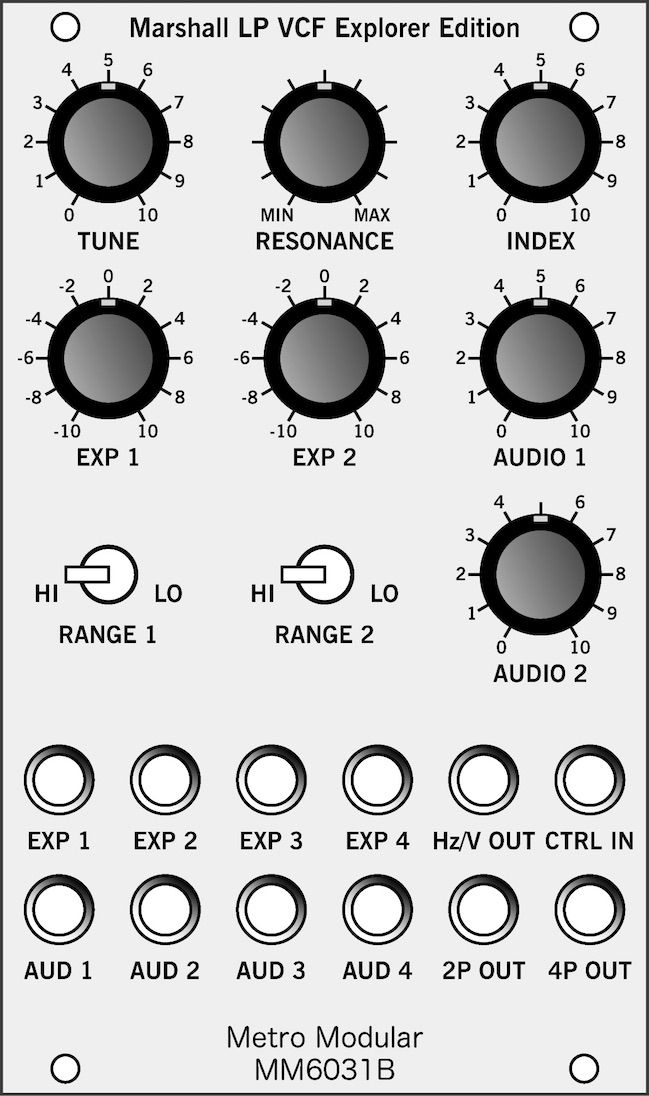All about it
Unique and deep!
This is Trevor Marshall's second filter design, for the ETI 3600 synth of 1975. A 4-pole lowpass, it was described in the magazine articles as having a more "commercial" sound than the original multimode filter, but we think it certainly is a wonderful filter in its own right.
It is unique in that it uses a frequency control mechanism consisting of a high-speed clock driving a fixed-length pulse generator to switch resistors in and out of the filter circuit at high speed to simulate a potentiometer. This gives it great fidelity (signals can pass through the circuit at full audio level, as with vactrol circuits) with a slight touch of funkiness due to the non-linearity of the CMOS switches themselves. Combine that with brassy Sallen-key filters (think lowpass gates), but with a very un-Sallen Key beautifully controlled resonance and self-oscillation courtesy of the 4-pole configuration.
This filter is also fairly exceptional in that it is a "native" Hz/V (linear) control design-even the Buchla LPG and Korg35 filters have an exponential response-and the fast linear transient response of this filter is great for snappy gating. This mode plays very nicely with the Hz/V mode of a Korg SQ-1, or a vintage Korg such as the X-911 guitar synth.
We have added a separate, temperature compensated exponential converter with a 4-input CV mixer for times when you want to have it track with the rest of your system. Just patch the Hz/V Out jack into the Control (input) jack. Simples! This also marks the first appearance of Buchlidian attenuverters in a Metro Modular product - EXP 1 is normalised to +6V so can be used as a tuning offset control if nothing is connected to its jack.
Tech Notes
This iteration of the module brings every possible input and output option from the "backpack" filter core board to the front panel and provides attenuators for every nearly every input. It is intended as a "feature playground" testing configuration to choose an optimum panel configuration for a 10HP version (hence the B suffix), but it is a fine choice for those who wish to deep-dive into exploring the filter's unique architecture.
Due to the need to keep filter clocking rates between the upper frequency limits of the CMOS switches while keeping the filter clock fast enough so it does not intrude on the audio range, the filter has slightly more than a 100:1 tuning range, hence the range switches to cover the entire frequency spectrum. Each range switch switches one of the two Sallen-Key filter blocks, and it is possible to put the range switches into "unofficial" combo positions for interesting results!
There is no low-pass filtering on the Control input. Patching either output into it and turning up the resonance is great fun!!! It does have a limit of about 5V with external signals, simply attenuate the tune pot to get full tuning range from your vintage Korg.
The original filter design has a brilliantly simple system that sends a fixed voltage through the Tune control when nothing is connected to the Control jack-which allows linear control to switch from "free run" to a connected control signal as soon as there is an electrical connection-no normalised jack required. The Index control is something we have added-it allows crossfading between the tune control offset and the external linear control signal-great for flattening out your V/Oct tracking too!
Tech Specs
Power requirements
+12V: 45mA
-12V: 45mA
+5V: Not required
Dimensions
Eurorack standard, 15HP width
38mm depth below mounting rails with connected power cable
Operation
User manual on its way!
Handwerk
Arbeit
In late prototyping; expected production early 2018
Produkte
Watch this space

